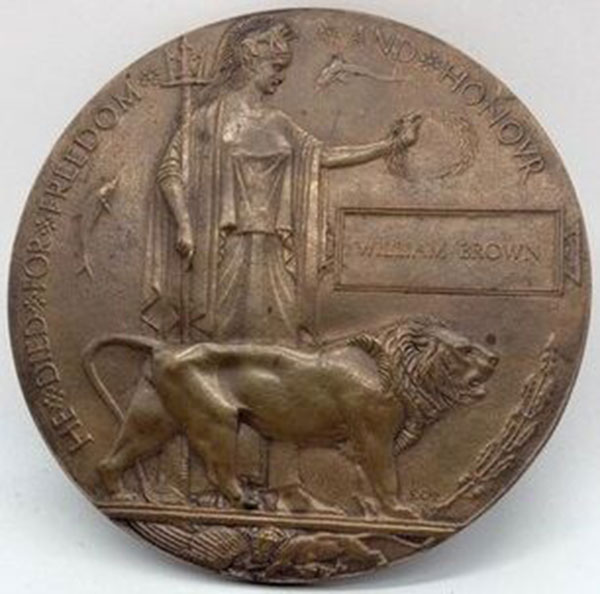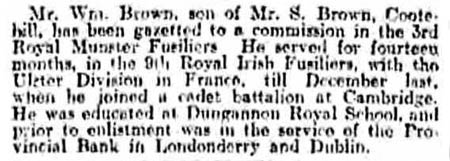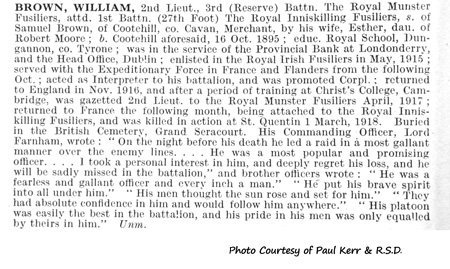| Date |
Information |
|
| 09/01/2021 |
 |
| 09/01/2021 |
2nd Lieutenant William Brown is buried in Grand-Seraucourt British Cemetery near St Quentin in France. His inscription reads: HE HAS BUT FOLLOWED WHITHER DUTY LED TO FIND A FULLER LIFE |
| 23/01/2017 |
Mr William Brown, son of Mr S Brown, Cootehill, has been gazetted to a commission in the 3rd Royal Munster Fusiliers. He served for fourteen months in the Royal Irish Fusiliers, with the Ulster Division in France, till September last, when he joined a cadet battalion at Cambridge. He was educated at Dungannon Royal School, and prior to enlistment was in the service of the Provincial Bank in Londonderry and Dublin. |
| 23/01/2017 |
 |
| 23/01/2017 |
From the Belfast Newsletter dated 17th April 1917: |
| 30/12/2015 |
The 1911 census records that William was now a boarder at the Royal School Dungannon. All three brothers attended the school. William was resident between 1910 and 1912. |
| 30/12/2015 |
By early 1918, 2nd Lieutenant William Brown was with 36th Ulster Division defending an area south of St Quentin, France. The Germans had not yet launched their spring Offensive (21st March), but were probing. |
| 30/12/2015 |
In May 1917, 2nd Lieutenant William Brown returned to France, being attached to the Royal Inniskilling Fusiliers. |
| 30/12/2015 |
William was gazetted 2nd Lieutenant to the Royal Munster Fusiliers in April 1917. |
| 30/12/2015 |
Corporal Brown returned to England in November 1916 for a period of training with a cadet unit at Christ's College, Cambridge. |
| 30/12/2015 |
2nd Lieutenant William Brown was killed in action on 1st March 1918. He was 22 years old. |
| 30/12/2015 |
After leaving school, William worked for the Provincial Bank in Londonderry and at Head Office in Dublin. |
| 30/12/2015 |
'He was a fearless and gallant officer and every inch a man.' |
| 30/12/2015 |
Known family: Samuel Brown, Esther Brown, Samuel Brown (born about 1892), William Brown (born 16th October 1895), Ernest Brown (born about 1898) |
| 30/12/2015 |
The 1901 census lists William as age 6 living with the family at house 46 in Bridge Street, Cootehill, Cavan. His mother and father were both listed as merchants. They had two assistants who were described as grocers. |
| 30/12/2015 |
In May 1915, William Brown enlisted in the Royal Irish Fusiliers. Private Brown served with the 9th Battalion of the Royal Irish Fusiliers with the Expeditionary Force in France and Flanders from October 1915. He acted as interpreter for several months to his battalion, and was promoted Corporal. |
| 30/12/2015 |
His commanding officer, Lord Farnham, wrote: |
| 30/12/2015 |
William Brown was the son of Samuel and Esther Brown (nee Moore). William was born in Cootehill, County Cavan on 16th October 1895. |
| 30/12/2015 |
Other officers in the battalion also wrote, with following quotes: |
| 30/12/2015 |
'He put his brave spirit into all under him.' |
| 30/12/2015 |
'His men thought the sun rose and set for him. They had absolute confidence in him and would follow him anywhere.' |
| 30/12/2015 |
'His platoon was easily the best in the battalion, and his pride in his men was only equalled by theirs in him' |
| 30/12/2015 |
The CWGC record 2nd Lieutenant William Brown as the son of Mr. and Mrs. S. Brown, of Cootehill, Co. Cavan. They also record that he enlisted in Royal Irish Fusiliers in May 1915 and was gazetted in April 1917. |
| 30/12/2015 |
Many thanks to Paul Kerr and the Royal School Dungannon for his research and all the information provided. |
| 30/12/2015 |
From De Ruvigny's Roll of Honour |
| 30/12/2015 |
 |
| 30/12/2015 |
Brown, William 2nd Lieutenant, 3rd Reserve Battalion of the Royal Munster Fusiliers, attended 1st Battalion (27th Foot) of the Royal Inniskilling Fusiliers. Son of Samuel Brown of Cootehill, County Cavan, Merchant, by his wife Esther, daughter of Robert Moore. Born Cootehill, County Cavan, 16th October 1895. Educated at the Royal School Dungannon, County Tyrone. Was in the service of the Provincial Bank in Londonderry and Head Office in Dublin. Enlisted in the Royal Irish Fusiliers in May 1915. Served with the Expeditionary Force in France and Flanders from the following October. Acted as interpreter to his battalion, and was promoted Corporal. Returned to England in November 1916, and after a period of training at Christ's College, Cambridge, was gazetted 2nd Lieutenant to the Royal Munster Fusiliers in April 1917; returned to France the following month, being attached to the Royal Inniskilling Fusiliers, and was killed in action at St Quentin on 1st March 1918. Buried in Grand-Seraucourt British Cemetery His commanding officer, Lord Farnham, wrote 'On the night before his death, he led a raid in a most gallant manner over the enemy lines. He was a most popular and promising officer. I took a personal interest in him, and deeply regret his loss, and he will be sadly missed in the battalion.' And brother officers wrote, 'He was a fearless and gallant officer and every inch a man. He put his brave spirit into all under him. His men thought the sun rose and set for him. They had absolute confidence in him and would follow him anywhere. His platoon was easily the best in the battalion, and his pride in his men was only equalled by theirs in him' |
| 30/12/2015 |
'On the night before his death, he led a raid in a most gallant manner over the enemy lines. He was a most popular and promising officer. I took a personal interest in him, and deeply regret his loss, and he will be sadly missed in the battalion.' |